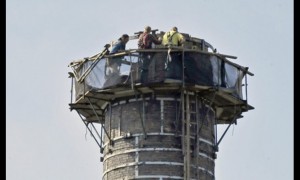Ian Benson
Editor-in-Chief
When the College made the switch from coal to natural gas last March, the smokestack that loomed over John P. Papp Stadium became unnecessary. A demolition team removed the campus landmark this summer because the campus’s new natural gas burners do not require such a large smokestack.
The College hired mechanical contractor Smith & Oby, which then hired sub-contractors to handle the physical demolition. A handful of construction workers used scaffolding to dismantle the smokestack bit by bit. The final 40 feet came down on Aug. 16. The whole removal process took roughly eight weeks.
The power plant and the 205 foot smokestack were built in 1939 and burned around 8,900 tons of coal annually.
Switching to natural gas was a cheaper option for the College than simply replacing its outdated coal burners with new ones, and by the College’s own estimates, the decision will help reduce the school’s carbon footprint by nearly 50 percent. The switch will also reduce annual fines the College receives from the EPA by nearly $20,000, end sulfur dioxide and lead emissions, and reduce nitrous oxide, arsenic and mercury emissions by over 90 percent.
The switch also leaves open the possibility that the College will add solar, wind or geothermal power in the future. Still, school administrators have not officially committed to any future projects.
“Getting rid of a coal-fired power plant is a powerful statement,” said Sb Loder, the College’s Sustainability Coordinator. “Removing a coal-firing power plant [is] an action that supports a commitment to the environment.” However, Loder expressed concern that the school does not seem to be undertaking any further steps to defend the environment.
Loder suggested that the College sign on to the American College & University Presidents’ Climate Commitment. That agreement would require the College to write its own plan to eventually achieve climate neutrality at its own pace, and to submit a yearly Greenhouse Gas Emissions Inventory, something the school has never done before. Loder also pointed out that although natural gas is a lower-emissions fuel than coal at the point of combustion, it’s estimated that the emissions savings from burning natural gas are totally negated when the extensive natural gas production process is considered.
Loder’s final concern was that the switch to natural gas encourages hydraulic fracturing (also known as fracking), a hotly contested method of natural gas extraction which can allegedly cause a multitude of environmental problems. The school’s decision to switch to natural gas will have some positive effects, but Loder hopes it is not the College’s endgame when it comes to energy efficiency and environmental protection.

